
Formula Dé
Author:
Lutz Pietschker
Version: 2002
Formula De House Rules
|
Games
|
Home Page
|
Links
|
What's New
This is the translation of an article I wrote for the
Berliner Spiele-Anzeiger, a Berlin games magazine run by Martina Hellmich. Published with friendly permission of BSA.
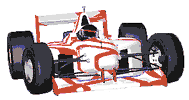 There are a lot of car-racing games, and some of them even make an attempt at a decent simulation of Formula 1 races. Some names: Speed Circuit (3M)certainly is one of the "classics"; in England, Lambourne Games offers The World of Motor Racing and Grand Prix Circus; in Germany we have the DTM Motorsportspiel (reviewed in the BSA); well, and then of course we have Formula Dé, from France.
There are a lot of car-racing games, and some of them even make an attempt at a decent simulation of Formula 1 races. Some names: Speed Circuit (3M)certainly is one of the "classics"; in England, Lambourne Games offers The World of Motor Racing and Grand Prix Circus; in Germany we have the DTM Motorsportspiel (reviewed in the BSA); well, and then of course we have Formula Dé, from France.
Those games provide views on different aspects of motor racing. Generally, they try to simulate the different properties of the cars, some of them also include driver characteristics. Car wear and accidents are taken into account some detail if the game does not, as in Grand Prix Circus, focus on the economical aspects of race team management. Of course the games include several circuits that are modelled, sometimes rather loosely, after existing Grand Prix circuits.
The games differ strongly in the method and detail of simulation. Speed Circuit offers a rather simple system of race tactics that works without dice. The World of Motor Racing is very detailed and accurate and is based on actual statistics, but the graphical design of the game is rather deplorable. This game has its focus not on tactical decisions of the players but on the replay of actual races, or of races that could have happened. In contrast, the DTM game has exquisite material, and players also comment favourably on the tactical elements. So where in the field does that put Formula Dé? As the name suggests (dé
is French for die) there is some luck element, and we should not expect a very close simulation. On the other hand the game has an international fan community, players have designed additional circuits, and tournaments have been held regularly for some years now. When the original publishers, Ludodélire, went out of business, Jeux Déscartes Eurogames took over and even expanded the game. So there must be something to it, after all...
Racing Atmosphere
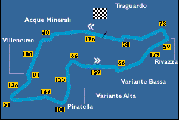 In one word, this is the strong side of Formula Dé. The material is a wonderful combination of large circuit plans that show international Grand Prix circuits, small plastic cars with differently coloured wings, and a well-structured set of rules. But for the moment, let us take a second look at the boards. I presume they are based on aerial photography, at least the abundance of details suggests as much. And it seems the graphics designers really had some fun when doing the 65 by 100 cm plans: The spectators on the grandstands and at the burger stalls, the cars on the parking lots, patches of flowers and trees, the rescue personnel- they are all there. And just to be not too realistic, out of each plan a typical local item soars towards the observer. In Zandvoort there's a windmill and a cyclist, lions and flamingos hover over Kyalami Circuit, and seagulls over Monaco. And if you examine the map closely you will find out why a canoeist rockets out of the Ferrari
autodromo
in San Marino...
In one word, this is the strong side of Formula Dé. The material is a wonderful combination of large circuit plans that show international Grand Prix circuits, small plastic cars with differently coloured wings, and a well-structured set of rules. But for the moment, let us take a second look at the boards. I presume they are based on aerial photography, at least the abundance of details suggests as much. And it seems the graphics designers really had some fun when doing the 65 by 100 cm plans: The spectators on the grandstands and at the burger stalls, the cars on the parking lots, patches of flowers and trees, the rescue personnel- they are all there. And just to be not too realistic, out of each plan a typical local item soars towards the observer. In Zandvoort there's a windmill and a cyclist, lions and flamingos hover over Kyalami Circuit, and seagulls over Monaco. And if you examine the map closely you will find out why a canoeist rockets out of the Ferrari
autodromo
in San Marino...
The central feature, of course, is the actual track (even two tracks in Zandvoort- a tiny go-cart track is included as a sort of add-on). The tracks are about 160 spaces long on average and have 3 lanes. The corners are especially important in the course of a race. They are marked and are tagged with a speed limit- more about that in the next section.
The game is driven by a set of special dice. Each die corresponds to one gear, and drivers may shift up one gear or two down each turn. Excessive downshifts cost wear points. The movement of the car is one roll on the current gear die which can be from 1-2 spaces in first gear to 21-30 spaces in 6th gear. You'll have to slow down for the corners, and the average speed will be 10-15 spaces per turn, but depending on the circuit of course. Cars move in order of current position, i.e. the leading car moves first each turn.
As many as 10 players (cars) can participate in a race, but the game is also quite playable with two players if each takes more than one car. For every car there is a "panel" with a gear bar and a pawn to mark the current gear. Also on the panel you do the bookkeeping for wear points. A car starts with a certain amount of wear points for tyres, transmission, body and engine. Collisions and bad handling consume these points. They are there to be used, to be sure, but if you wear the car down early in the race you'll have to go very carefully later on not to risk a total failure and elimination. The prudent use of wear points is a major tactical element of the game.
Corner: Gears, Brakes, and Go!
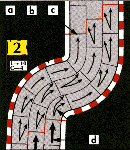 As in a real race, the cornering skills decide about victory or defeat. Each corner is tagged with a minimum number of turns cars must use to negotiate it; this limits corner speed. So, a "2" corner demands that the car must end two moves inside the corner area. Excess speed can be braked down (at the expense of break wear), and if the car is still too fast and overshoots the corner it costs tyre wear points. You can't take a lot of liberties with those points: For a 1-lap-race only 3 brake and 4 tyre wear points are available, and they wear off fast indeed. After that there will be only a wide black skid mark on the tarmac which ends in the rough.
As in a real race, the cornering skills decide about victory or defeat. Each corner is tagged with a minimum number of turns cars must use to negotiate it; this limits corner speed. So, a "2" corner demands that the car must end two moves inside the corner area. Excess speed can be braked down (at the expense of break wear), and if the car is still too fast and overshoots the corner it costs tyre wear points. You can't take a lot of liberties with those points: For a 1-lap-race only 3 brake and 4 tyre wear points are available, and they wear off fast indeed. After that there will be only a wide black skid mark on the tarmac which ends in the rough.
Cornering is tricky because you never know exactly how fast you will go in a turn- the dice take care of that. In addition you are not free to change lanes in a corner but must follow driving lines marked by printed arrows. It is not easy to find the right mixture of caution and boldness, and an unlucky roll of a die can hamper a car seriously or even force it to retire. Certainly there are players that seem to bounce less often than others, so there must be some skill involved, after all. Nevertheless, the chance factor that can make or break your race is too strong to call the game a real simulation.
But Formula Dé is a beautiful car racing game. From the first moment that Grand Prix atmosphere is present. and the turn sequence of gear change, die roll and move is fast enough to prevent boredom even with a field of 10 cars- provided you do not have a player in your group who insists on counting spaces and calculating probabilities before each move. This problem, however, is not specific to Formula Dé and can easily be solved by means of an egg-timer and some stern advice.
Hitches and Glitches
 Even the basic rules have some details I did not mention so far. Some of them are useful, others seem rather strange and are a double annoyance, both as an irritation for the player and as an incomprehensible squiggle in the eyes of the gamer that looks for a simulation game. For example, we have "damage socialism": If
one
car rolls maximum speed in 5th or 6th gear,
all
cars going in high gears take engine damage. Why all of them? Also, the advanced rules for multi-lap races make proposals, besides some sensible rules about weather influence and choice of tyres, that did not convince me at all. For example, a pit stop just might cause the serviced car to overtake the complete field via the pit lane, i.e. it may actually be faster with the stop than without it. The slipstreaming rules are another example of concepts I could not relate to anything in reality.
Even the basic rules have some details I did not mention so far. Some of them are useful, others seem rather strange and are a double annoyance, both as an irritation for the player and as an incomprehensible squiggle in the eyes of the gamer that looks for a simulation game. For example, we have "damage socialism": If
one
car rolls maximum speed in 5th or 6th gear,
all
cars going in high gears take engine damage. Why all of them? Also, the advanced rules for multi-lap races make proposals, besides some sensible rules about weather influence and choice of tyres, that did not convince me at all. For example, a pit stop just might cause the serviced car to overtake the complete field via the pit lane, i.e. it may actually be faster with the stop than without it. The slipstreaming rules are another example of concepts I could not relate to anything in reality.
The Germany translation is not particularly logical, either. For example, transmission wear is translated as "fuel consumption", which, of all times, occurs when down-shifting the gears.
I should mention that there is an optional rule that allows to influence car construction. Before the start of the race players can distribute a number of wear points between tyres, brakes, transmission, engine and body and thus give their car a special characteristic that does (or at least should) influence the driving style.
House Rules
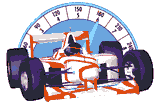 There are those games I open, play them once or twice and begin to think about house rules during the third game at latest. It is that "something-more-could-be-made-of-that-stuff" feeling. Formula Dé is typical for the species, and discussion and rules variants found on the internet indicate that I am not the only one to feel it. The question is how far to go: Shall the material be used to make a new game, or are you satisfied to iron out the creases of the original rules?
There are those games I open, play them once or twice and begin to think about house rules during the third game at latest. It is that "something-more-could-be-made-of-that-stuff" feeling. Formula Dé is typical for the species, and discussion and rules variants found on the internet indicate that I am not the only one to feel it. The question is how far to go: Shall the material be used to make a new game, or are you satisfied to iron out the creases of the original rules?
Some points seem obvious targets to me: I wanted to find a sensible slipstreaming rule, to make pit stops more realistic, and to eliminate the dice. Also, from the first moment I did not like the fact that overtaking should be a no-risk activity and that the overtaken driver should be defenceless. After all, what you hear in the news about collisions, squabbling and protests is nearly always connected to overtaking!
Unfortunately, for this last problem I have no solution yet. A modified pitstop rule has been published by Christian Schnabel in the
Spielbox
magazine. A slipstreaming rule could be sketched similar to that of the bike racing game "Um Reifenbreite" (Homas Tour): Instead of using the movement he rolled, a driver may decide to follow the driver immediately in front of him. His advantage would be that he may do this even if he is one gear lower than the other car and thus may save some wear points.
A replacement for the dice is easy to find: The Speed Circuit car panels are just the thing for it. Gears 1 to 4 correspond to the speeds 30 to 120, the 5th gear is 150 to 180, and the 6th gear covers the other three speeds up to 270:
|
Gear
|
1
|
2
|
3
|
4
|
5
|
6
|
|
Die
|
yellow
1-2
|
orange
3-4
|
red
4-8
|
green
7-12
|
violet
11-20
|
blue
21-30
|
|
Speed
|
1-2
|
3-4
|
4-8
|
7-12
|
11-15
|
16-20
|
21-24
|
25-27
|
28-30
|
|
Speedo Read
|
30
|
60
|
90
|
120
|
150
|
180
|
210
|
240
|
270
|
In 5th and 6th gear you must mark not only the gear but also in which segment of the gear you want to drive. A change of segment does not count as a gear change. The correlation between gear, segments and speed is illustrated in the table above.
The player only decides the moment he actually moves how many spaces he will go, inside the range of the segment chosen. All players switch gears before the first car moves.
Those house rules are not fully tested, so please take them just as a proposal. I am always glad to get other opinions and playtesting reports.
Can You Simulate Formula 1 At All?
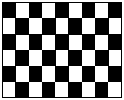 What is it that we expect when hearing "Formula 1"? I associate words like speed, tension and danger. I see drivers and pretty girls. I smell gasoline and hear droning engines and excited reporters. Accordingly, a whiff of those elements should be in any F1 game, and the play must be really fast and dynamic. Then, there are the famous Grand Prix circuits on which I want to go a few rounds, if only at the livingroom table. Drivers and cars should be detailed enough to recognize their strengths and weaknesses in the game. I want to re-create tactical elements of a race like pit stops, qualification rounds, choice of tyres and co-operation of drivers of one team. And last but not least I want to be able to use driving tactics like slipstreaming, cornering and overtaking. A simultaneous movement system closes my wish list.
What is it that we expect when hearing "Formula 1"? I associate words like speed, tension and danger. I see drivers and pretty girls. I smell gasoline and hear droning engines and excited reporters. Accordingly, a whiff of those elements should be in any F1 game, and the play must be really fast and dynamic. Then, there are the famous Grand Prix circuits on which I want to go a few rounds, if only at the livingroom table. Drivers and cars should be detailed enough to recognize their strengths and weaknesses in the game. I want to re-create tactical elements of a race like pit stops, qualification rounds, choice of tyres and co-operation of drivers of one team. And last but not least I want to be able to use driving tactics like slipstreaming, cornering and overtaking. A simultaneous movement system closes my wish list.
The necessary dynamics of play are obviously at contrast with the wish for detailed manoeuvring. Some decisions are made before the race starts, when players can take their time for preparation; after that they must have boiled down to very few and clear property numbers. During the race there must be no table look-ups or dice orgies. At this time, the player should be able to concentrate on his drivers' problems and on quick decision-making.
There are very good reasons indeed why existing F1 games fall short of my expectations. A simple calculation shows where the problem lies:
Most circuits are 4-5 km per round and cars go at an average speed of 120 to 140 km/h. At 40 to 70 rounds this comes down to 1.5 to 2.5 minutes per round. Though the 1-2 hours racing time would also be a very convenient playing time, no game will be able to simulate the race in real time. With 4 players, let us assume a good system should not need more than 2-3 minutes per game turn which gives room for 20 to 30 rounds in the playing time. But if you consider that each real-life circuit has at least 10 critical spots like chicanes and typical corners that should be negotiated by the players you find that you will not be able to run more than 2 to 3-lap races- exactly the number that is common to most existing F1 games. However, this number of laps is far too small to test driver endurance or make the the necessity of pit stops convincing.
So, the ideal F1 game has not been designed yet. I suspect that it would not sport the gorgeous map graphics of Formula Dé. It will have easy mechanics to achieve short and dynamic game turns, and players will have to sacrifice some detail or at least to accept a compressed and simplified representation of it. The World of Motor Racing (Lambourne Games) shows an interesting approach: Here, races are run in segments, each representing 1 or more laps. At randomly chosen moments, driving skill and cars are tested. However, this is done in a fairly abstract manner and not even using a "real" circuit map.
My summary? As long as my ideal F1 game has not yet been designed, I'll gladly continue to play Formula Dé!
As the author of this page I take no expressed or implied responsibility for the content of external links; opinions expressed on such pages are not necessarily mine. The web space provider is not responsible for the contents of this page or any linked pages.


Written and published by Lutz Pietschker. Please send comments about technical problems to the
site master.
-Made with a Mac!-
, last change
2011-03-12
 There are a lot of car-racing games, and some of them even make an attempt at a decent simulation of Formula 1 races. Some names: Speed Circuit (3M)certainly is one of the "classics"; in England, Lambourne Games offers The World of Motor Racing and Grand Prix Circus; in Germany we have the DTM Motorsportspiel (reviewed in the BSA); well, and then of course we have Formula Dé, from France.
There are a lot of car-racing games, and some of them even make an attempt at a decent simulation of Formula 1 races. Some names: Speed Circuit (3M)certainly is one of the "classics"; in England, Lambourne Games offers The World of Motor Racing and Grand Prix Circus; in Germany we have the DTM Motorsportspiel (reviewed in the BSA); well, and then of course we have Formula Dé, from France.
 In one word, this is the strong side of Formula Dé. The material is a wonderful combination of large circuit plans that show international Grand Prix circuits, small plastic cars with differently coloured wings, and a well-structured set of rules. But for the moment, let us take a second look at the boards. I presume they are based on aerial photography, at least the abundance of details suggests as much. And it seems the graphics designers really had some fun when doing the 65 by 100 cm plans: The spectators on the grandstands and at the burger stalls, the cars on the parking lots, patches of flowers and trees, the rescue personnel- they are all there. And just to be not too realistic, out of each plan a typical local item soars towards the observer. In Zandvoort there's a windmill and a cyclist, lions and flamingos hover over Kyalami Circuit, and seagulls over Monaco. And if you examine the map closely you will find out why a canoeist rockets out of the Ferrari
autodromo
in San Marino...
In one word, this is the strong side of Formula Dé. The material is a wonderful combination of large circuit plans that show international Grand Prix circuits, small plastic cars with differently coloured wings, and a well-structured set of rules. But for the moment, let us take a second look at the boards. I presume they are based on aerial photography, at least the abundance of details suggests as much. And it seems the graphics designers really had some fun when doing the 65 by 100 cm plans: The spectators on the grandstands and at the burger stalls, the cars on the parking lots, patches of flowers and trees, the rescue personnel- they are all there. And just to be not too realistic, out of each plan a typical local item soars towards the observer. In Zandvoort there's a windmill and a cyclist, lions and flamingos hover over Kyalami Circuit, and seagulls over Monaco. And if you examine the map closely you will find out why a canoeist rockets out of the Ferrari
autodromo
in San Marino...
 As in a real race, the cornering skills decide about victory or defeat. Each corner is tagged with a minimum number of turns cars must use to negotiate it; this limits corner speed. So, a "2" corner demands that the car must end two moves inside the corner area. Excess speed can be braked down (at the expense of break wear), and if the car is still too fast and overshoots the corner it costs tyre wear points. You can't take a lot of liberties with those points: For a 1-lap-race only 3 brake and 4 tyre wear points are available, and they wear off fast indeed. After that there will be only a wide black skid mark on the tarmac which ends in the rough.
As in a real race, the cornering skills decide about victory or defeat. Each corner is tagged with a minimum number of turns cars must use to negotiate it; this limits corner speed. So, a "2" corner demands that the car must end two moves inside the corner area. Excess speed can be braked down (at the expense of break wear), and if the car is still too fast and overshoots the corner it costs tyre wear points. You can't take a lot of liberties with those points: For a 1-lap-race only 3 brake and 4 tyre wear points are available, and they wear off fast indeed. After that there will be only a wide black skid mark on the tarmac which ends in the rough.
 Even the basic rules have some details I did not mention so far. Some of them are useful, others seem rather strange and are a double annoyance, both as an irritation for the player and as an incomprehensible squiggle in the eyes of the gamer that looks for a simulation game. For example, we have "damage socialism": If
one
car rolls maximum speed in 5th or 6th gear,
all
cars going in high gears take engine damage. Why all of them? Also, the advanced rules for multi-lap races make proposals, besides some sensible rules about weather influence and choice of tyres, that did not convince me at all. For example, a pit stop just might cause the serviced car to overtake the complete field via the pit lane, i.e. it may actually be faster with the stop than without it. The slipstreaming rules are another example of concepts I could not relate to anything in reality.
Even the basic rules have some details I did not mention so far. Some of them are useful, others seem rather strange and are a double annoyance, both as an irritation for the player and as an incomprehensible squiggle in the eyes of the gamer that looks for a simulation game. For example, we have "damage socialism": If
one
car rolls maximum speed in 5th or 6th gear,
all
cars going in high gears take engine damage. Why all of them? Also, the advanced rules for multi-lap races make proposals, besides some sensible rules about weather influence and choice of tyres, that did not convince me at all. For example, a pit stop just might cause the serviced car to overtake the complete field via the pit lane, i.e. it may actually be faster with the stop than without it. The slipstreaming rules are another example of concepts I could not relate to anything in reality.
 There are those games I open, play them once or twice and begin to think about house rules during the third game at latest. It is that "something-more-could-be-made-of-that-stuff" feeling. Formula Dé is typical for the species, and discussion and rules variants found on the internet indicate that I am not the only one to feel it. The question is how far to go: Shall the material be used to make a new game, or are you satisfied to iron out the creases of the original rules?
There are those games I open, play them once or twice and begin to think about house rules during the third game at latest. It is that "something-more-could-be-made-of-that-stuff" feeling. Formula Dé is typical for the species, and discussion and rules variants found on the internet indicate that I am not the only one to feel it. The question is how far to go: Shall the material be used to make a new game, or are you satisfied to iron out the creases of the original rules?
 What is it that we expect when hearing "Formula 1"? I associate words like speed, tension and danger. I see drivers and pretty girls. I smell gasoline and hear droning engines and excited reporters. Accordingly, a whiff of those elements should be in any F1 game, and the play must be really fast and dynamic. Then, there are the famous Grand Prix circuits on which I want to go a few rounds, if only at the livingroom table. Drivers and cars should be detailed enough to recognize their strengths and weaknesses in the game. I want to re-create tactical elements of a race like pit stops, qualification rounds, choice of tyres and co-operation of drivers of one team. And last but not least I want to be able to use driving tactics like slipstreaming, cornering and overtaking. A simultaneous movement system closes my wish list.
What is it that we expect when hearing "Formula 1"? I associate words like speed, tension and danger. I see drivers and pretty girls. I smell gasoline and hear droning engines and excited reporters. Accordingly, a whiff of those elements should be in any F1 game, and the play must be really fast and dynamic. Then, there are the famous Grand Prix circuits on which I want to go a few rounds, if only at the livingroom table. Drivers and cars should be detailed enough to recognize their strengths and weaknesses in the game. I want to re-create tactical elements of a race like pit stops, qualification rounds, choice of tyres and co-operation of drivers of one team. And last but not least I want to be able to use driving tactics like slipstreaming, cornering and overtaking. A simultaneous movement system closes my wish list.